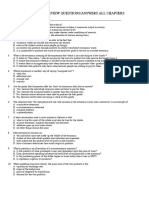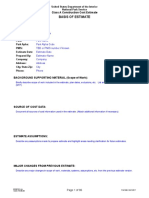Mcqs PPF Students)
Mcqs PPF Students)
Uploaded by
Ali HadiCopyright:
Available Formats
Mcqs PPF Students)
Mcqs PPF Students)
Uploaded by
Ali HadiOriginal Title
Copyright
Available Formats
Share this document
Did you find this document useful?
Is this content inappropriate?
Copyright:
Available Formats
Mcqs PPF Students)
Mcqs PPF Students)
Uploaded by
Ali HadiCopyright:
Available Formats
Chapter 6 : Multiple Choice Questions 1. When economists refer to scarcity they mean: a.
Population growth will lead to massive shortages of goods in the future. b. Resources are finite in quantity c. Human desires for goods are greater than the available resources d. Human desires for goods and services are infinite
2. Which of the following is a capital good? a. b. c. d. Investments in education Water A grill to cook hamburgers Lumber
3. Opportunity cost refers to: a. b. c. d. The amount of money you spend to purchase a good What you give up when you make an economic choice The opportunities that you receive when you make a choice All of the economic opportunities that are available to you
4. The opportunity cost of increased defense spending is: a. b. c. d. The money that is spent on defense $300 billion dollars 3.4% of output The production of other goods which could be produced with those same resources
5. Which of the following does not describe scarce resources: a. b. c. d. There is a limited amount of resources The amount of labor available is always changing The capital stock of a nation is fixed for the moment There is only so much technological knowledge available
6. In drawing a countrys production possibility curve, we assume that:
a. b. c. d.
Technology will change over time The economy will be producing at a point of efficient production The number of workers available for production is infinite The available resources are fixed in quantity
Figure 1-1 A Production Possibility Graph
Consumer Goods Pt A
Pt D
Pt C Pt B
Defense Goods
7. In Figure 1-1, points A and B are: a. b. c. d. Possible to produce with current resources Impossible to produce with current resources Represent inefficient uses of resources Not desirable
8. In Figure 1-1, which point represents an economy at less than full production?
a. b. c. d.
Point A Point B Point C Point D
9. In Figure 1-1, the production possibilities curve implies all of the following except: a. Opportunity costs are constant b. Scarcity requires economic choices c. The shape of the production possibilities curve illustrates the law of increasing cost d. An increase in the production of more defense goods means fewer consumer goods
10. In Figure 1-1, which point represents a point where some resources are not being utilized? a. b. c. d. Point A Point B Point C Point D
11. The law of increasing opportunity cost exists because: a. b. c. d. Resources can be easily moved from one industry to another It is difficult to move resources from one industry to another Resources are scarce Opportunity costs remain the same as you change the mix of output
12. The WHAT question refers to: a. b. c. d. Will products be made with machines? How will goods be distributed? Will we produce more defense goods or more consumer goods? Will products be made efficiently or not?
13. Adam Smith, the author of The Wealth of Nations, argued that the WHAT economic question should be handled by: a. The invisible hand
b. What consumers want to buy c. What is most profitable to business d. All of the above
14. India is privatizing state enterprises because: a. India was producing at a point inside the production possibility curve b. Government-run companies were not efficient c. The market better determines what to produce d. All of the above
15. The FOR WHOM question in a market economy is answered by: a. b. c. d. The most profitable way to produce a good What is in demand The person who is willing to pay the price The most efficient way to produce a good
True or False Questions 1. The United States economy is so affluent, that it does not face the scarcity problem. 2. Economics is the study of how to use scarce resources. 3. The government of North Korea decided to increase food production and give up military production. 4. All choices on the production possibility curve are both desirable and efficient. 5. India is attempting to move its production from a point inside their production possibility curve to one on the curve.
You might also like
- Basic Economics MCQs With AnswersDocument32 pagesBasic Economics MCQs With AnswersNasir Nadeem76% (33)
- Essentials of Development Economics, Third EditionFrom EverandEssentials of Development Economics, Third EditionRating: 5 out of 5 stars5/5 (1)
- 1st Quarter Examination For Applied EconomicsDocument6 pages1st Quarter Examination For Applied EconomicsSyrene Fronda93% (14)
- Microeconomics 5th Edition Krugman Test BankDocument45 pagesMicroeconomics 5th Edition Krugman Test Bankmarkhuffmanydftbpjgas100% (16)
- AP Micro Unit 1 Practice QuestionsDocument4 pagesAP Micro Unit 1 Practice QuestionsSunny SinghNo ratings yet
- Economics MCQsDocument168 pagesEconomics MCQsSanjeev Subedi83% (23)
- Test Bank For Microeconomics in Modules, 5e Paul Krugman, Robin Wells Test BankDocument42 pagesTest Bank For Microeconomics in Modules, 5e Paul Krugman, Robin Wells Test BankNail BaskoNo ratings yet
- What Is The Importance ofDocument2 pagesWhat Is The Importance ofZul Fikri100% (1)
- VI. 80% Owned-Subsidiary: Cost Model - Full Goodwill Approach Downstream and Upstream of Property, Unrealized Gain and Realized Gain On SaleDocument3 pagesVI. 80% Owned-Subsidiary: Cost Model - Full Goodwill Approach Downstream and Upstream of Property, Unrealized Gain and Realized Gain On SaleMa'arifa HussainNo ratings yet
- Macro Economy Today 14th Edition Hill Test BankDocument153 pagesMacro Economy Today 14th Edition Hill Test BankEricBrewermpijb100% (15)
- Class 11 Micro Economics AssignmentDocument8 pagesClass 11 Micro Economics Assignmentyashikagupta10a.doonNo ratings yet
- Economics Model Question 1st TermDocument7 pagesEconomics Model Question 1st TermRaktimNo ratings yet
- Ca F Eco 1 To 3Document12 pagesCa F Eco 1 To 3G. DhanyaNo ratings yet
- Unit 1 Assessment - Basic Economics ConceptsDocument11 pagesUnit 1 Assessment - Basic Economics ConceptsNIKHILNARAYAN VANKADARANo ratings yet
- Applied EconomicsDocument7 pagesApplied EconomicsSanchinoDeeNo ratings yet
- ch.1 Micro Class 11 NotesDocument4 pagesch.1 Micro Class 11 NotesKanak GuptaNo ratings yet
- Summative Test in App Econ 1Document4 pagesSummative Test in App Econ 1Ronnel Pardos100% (1)
- Micro Prelim BDocument3 pagesMicro Prelim Bvianvi3No ratings yet
- Unit I and II PracticeDocument16 pagesUnit I and II Practicettuana.ozturkk05No ratings yet
- TEST12019Document8 pagesTEST12019ntingasmangaliso52No ratings yet
- Test 1: StudentDocument2 pagesTest 1: StudentSandy LNo ratings yet
- Faounfation - June - Eco - MockDocument12 pagesFaounfation - June - Eco - Mockrahimkk122No ratings yet
- Exam1 Practice Exam SolutionsDocument37 pagesExam1 Practice Exam SolutionsSheehan T Khan100% (3)
- The Fundamental Economic Problem Faced by All Societies IsDocument26 pagesThe Fundamental Economic Problem Faced by All Societies IsSaeed Ali Abbasi100% (1)
- Agecon TugDocument12 pagesAgecon Tugjuliet udaundoNo ratings yet
- Economics 100 Quiz 1Document15 pagesEconomics 100 Quiz 1Ayaz AliNo ratings yet
- Lecture:1 Foundations of Economics What Comes To Your Mind When You Hear The Word SCARCE?Document55 pagesLecture:1 Foundations of Economics What Comes To Your Mind When You Hear The Word SCARCE?Sufyan AhmedNo ratings yet
- Preguntas EconomiaDocument3 pagesPreguntas EconomiaGrecia Aranza Odette Quirarte RivasNo ratings yet
- Economics Questions Unit 1Document5 pagesEconomics Questions Unit 1raeydesta2012No ratings yet
- Exercise 3-12Document44 pagesExercise 3-12api-3769920No ratings yet
- Practice Quizzes Topic 1-C1 - 2Document5 pagesPractice Quizzes Topic 1-C1 - 2phươngNo ratings yet
- MACRO Practice TestDocument22 pagesMACRO Practice TestTee_Tee57No ratings yet
- Ch1 3 ReviewerDocument13 pagesCh1 3 ReviewerGreen StoneNo ratings yet
- Scarcity, Choice, and Opportunity Costs: T OutlineDocument11 pagesScarcity, Choice, and Opportunity Costs: T OutlineFurqan ArifNo ratings yet
- Econ 11 Exercise Set No. 1Document3 pagesEcon 11 Exercise Set No. 1orangemonkey2014No ratings yet
- Economics MCQsDocument14 pagesEconomics MCQsAsad AliNo ratings yet
- Applied Economics: Module No. 1: Week 1: First QuarterDocument8 pagesApplied Economics: Module No. 1: Week 1: First QuarterGellegani, Julius100% (1)
- 201 - 202 20th Ed Test 1 PacketDocument12 pages201 - 202 20th Ed Test 1 PacketRobert ClarkNo ratings yet
- EconomicsDocument4 pagesEconomicspastorpantemgNo ratings yet
- Micro Chapter 2 Study Guide Questions 14eDocument6 pagesMicro Chapter 2 Study Guide Questions 14eBeauponte Pouky MezonlinNo ratings yet
- Basic Econ Review Questions Answers All ChaptersDocument84 pagesBasic Econ Review Questions Answers All ChaptersGinnie G CristalNo ratings yet
- AC 2203 Long Exam 1 TestpaperDocument12 pagesAC 2203 Long Exam 1 TestpaperIssah Marie HingabayNo ratings yet
- Applied Econ Third Quarter ExamDocument3 pagesApplied Econ Third Quarter ExamFritzie EsmaldeNo ratings yet
- Applied EconomicsDocument3 pagesApplied EconomicsJune Mark50% (2)
- Finals (2nd Term, 2nd Sem)Document13 pagesFinals (2nd Term, 2nd Sem)Rechel Mae DatulaytaNo ratings yet
- Economics EOQ 2019Document9 pagesEconomics EOQ 2019Charles AbelNo ratings yet
- Section 1, English SectionDocument3 pagesSection 1, English Sectiongergeskhaled0No ratings yet
- Microeconomics Practical Exercises: Topic 1 - 4 Section 1: Multiple Choice QuestionsDocument12 pagesMicroeconomics Practical Exercises: Topic 1 - 4 Section 1: Multiple Choice QuestionsNgoc NguyenNo ratings yet
- Mic Chapt 1-10Document37 pagesMic Chapt 1-10Burhan BukhariNo ratings yet
- Questions. 1. Scarcity: A. Exists... : Question: Microeconomics Multiple Choice Questions. Please Answer All TheDocument14 pagesQuestions. 1. Scarcity: A. Exists... : Question: Microeconomics Multiple Choice Questions. Please Answer All TheRubina Hannure67% (3)
- Applied Economics - Midterm ExamDocument6 pagesApplied Economics - Midterm Examaquinorica00No ratings yet
- S1 Practice TestDocument6 pagesS1 Practice TestSraavaniNo ratings yet
- ECO402 Solved MCQs in One FileDocument47 pagesECO402 Solved MCQs in One FileAb DulNo ratings yet
- Economic Development - Mock ExaminationDocument15 pagesEconomic Development - Mock ExaminationLeilei GalangNo ratings yet
- International Relations: A Simple IntroductionFrom EverandInternational Relations: A Simple IntroductionRating: 5 out of 5 stars5/5 (9)
- Economic Terms: Dr. Tariq Hussain CVAS, JhangDocument21 pagesEconomic Terms: Dr. Tariq Hussain CVAS, JhangMuhammad Shahzad ChandiaNo ratings yet
- Energy: The Transition From Depletable To Renewable ResourcesDocument35 pagesEnergy: The Transition From Depletable To Renewable ResourcesMuhammad Jahanzeb AamirNo ratings yet
- Amusements in MathematicsDocument353 pagesAmusements in Mathematicshjalvino9446No ratings yet
- Relevant Costs For Decision Making: Management Accounting 1Document87 pagesRelevant Costs For Decision Making: Management Accounting 1georgeNo ratings yet
- AllotmentDocument4 pagesAllotmentJimmySkipperNo ratings yet
- M5 CVPCMLimitingFactorDocument24 pagesM5 CVPCMLimitingFactorAishveen Kaur SanghaNo ratings yet
- Introduction To Money Payment System-2Document42 pagesIntroduction To Money Payment System-2lawwrrance chanNo ratings yet
- Adani Ports and Sez Economic Zone Companyname: Strong Quarter Encouraging GuidanceDocument13 pagesAdani Ports and Sez Economic Zone Companyname: Strong Quarter Encouraging GuidanceAmey TiwariNo ratings yet
- Aero Asia Int - 11Document62 pagesAero Asia Int - 11Bhatti FarahNo ratings yet
- MKT 202 PresentationDocument17 pagesMKT 202 PresentationNoman100% (2)
- Us Partner 2Document10 pagesUs Partner 2seemabNo ratings yet
- BoLinkedObject EnumerationDocument3 pagesBoLinkedObject EnumerationaruntbNo ratings yet
- Percent Practice SheetDocument55 pagesPercent Practice SheetkamalNo ratings yet
- Questionnaire For WalletDocument4 pagesQuestionnaire For WalletShubhendu Tiwari0% (1)
- Cost Estimation Excell SheetDocument86 pagesCost Estimation Excell SheetMuhammad Al-ShaibahNo ratings yet
- Wesco CaseDocument14 pagesWesco CaseVarun BaxiNo ratings yet
- Elasticity and Its Application - Sunardi Daulay - 2005092003Document55 pagesElasticity and Its Application - Sunardi Daulay - 2005092003Nardi DaulayNo ratings yet
- Prepared By: Fernando Quijano and Yvonn Quijano: - Macroeconomics, 5/e - Olivier BlanchardDocument40 pagesPrepared By: Fernando Quijano and Yvonn Quijano: - Macroeconomics, 5/e - Olivier BlanchardArief KurniawanNo ratings yet
- Chopra3 PPT ch08Document24 pagesChopra3 PPT ch08benazi22No ratings yet
- PHD in Economics, Lecturer Professor, "Dimitrie Cantemir" Christian University BraşovDocument6 pagesPHD in Economics, Lecturer Professor, "Dimitrie Cantemir" Christian University BraşovellennaNo ratings yet
- Reviewer Opm and TQMDocument7 pagesReviewer Opm and TQMRose Anne BautistaNo ratings yet
- Analyst Briefing Note Aspect Enterprise SolutionsDocument3 pagesAnalyst Briefing Note Aspect Enterprise SolutionsCTRM CenterNo ratings yet
- General Motors SolutionDocument6 pagesGeneral Motors SolutionVinod PerkashNo ratings yet
- Project Procurement Management (PPM)Document373 pagesProject Procurement Management (PPM)Muhammad Mubeen Iqbal Puri100% (1)
- Rajesh and GoelDocument8 pagesRajesh and GoelSwetaSaroj50% (2)
- Review Chapter 8-10 WK Session With AnswerDocument13 pagesReview Chapter 8-10 WK Session With AnswerJijisNo ratings yet
- Accounting Hw3Document2 pagesAccounting Hw3Jeffery WilliamsNo ratings yet
- Boston Beer-Is Greater Growth PossibleDocument5 pagesBoston Beer-Is Greater Growth PossibleAlrifai Ziad AhmedNo ratings yet

























































































